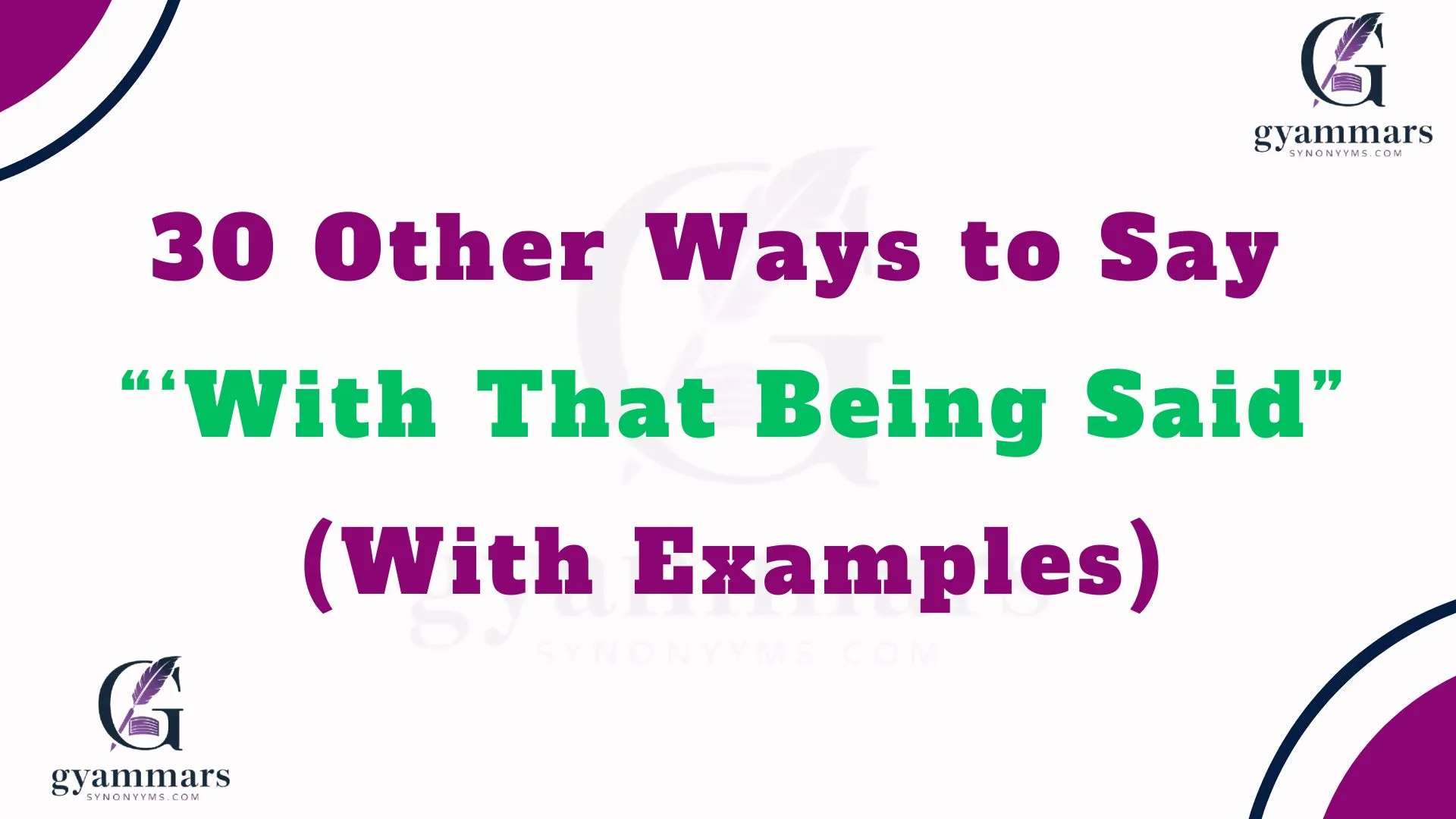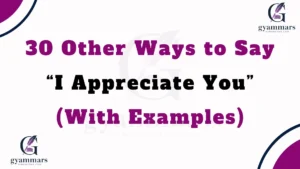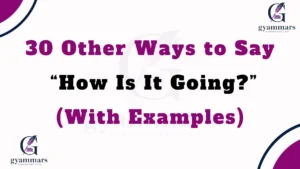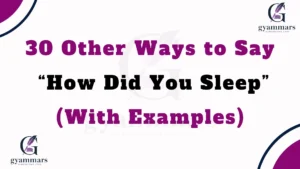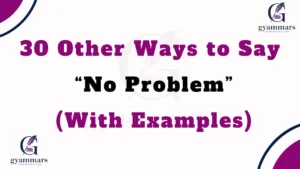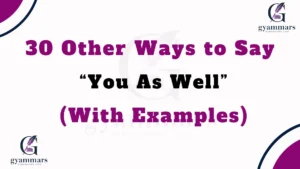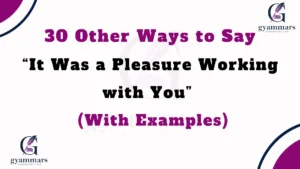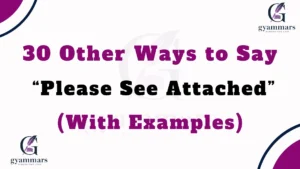Choosing the right words to transition smoothly between thoughts is essential in both casual and professional conversations. While “With that being said” is a widely used phrase, using alternative expressions can add warmth, variety, and depth to your speech or writing. This article provides 30 meaningful and polished alternatives to “With that being said”, ensuring that your communication feels natural, engaging, and effective.
What Does “With That Being Said” Mean?
“With that being said” is a transitional phrase that introduces a conclusion, contrast, or follow-up statement based on what was previously mentioned. It often signals a shift in thought while maintaining a logical flow.
Is It Professional/Polite to Say “With That Being Said”?
Yes, “With that being said” is generally professional and polite. However, overusing it may make your writing or speech sound repetitive. Choosing alternative phrases can make your communication more engaging and dynamic.
Pros and Cons of Using “With That Being Said”
Pros:
- Smooth transition between ideas
- Works in both formal and informal settings
- Easily understood by all audiences
Cons:
- Can sound repetitive if overused
- Might feel too formal in casual conversations
- Lacks emotional warmth in some contexts
Synonyms For “With That Being Said”
- That Being Said
- Having Said That
- However
- That Said
- Even So
- Nonetheless
- In Other Words
- On That Note
- In Light of That
- Therefore
- As a Result
- All Things Considered
- That Brings Us To
- To That End
- Given That
- On the Other Hand
- As Such
- In Turn
- Simply Put
- With This in Mind
- In Other Terms
- Keeping That in Mind
- Taking That Into Account
- Accordingly
- On a Related Note
- As a Consequence
- In the Same Vein
- Following That
- To Wrap Things Up
- With This Being Said
1. That Being Said
Definition: A shorter, slightly more casual version of the phrase.
Detailed Explanation: Works just like “With that being said,” but is a bit more concise.
Scenario Example: “This plan has some risks. That being said, I believe it’s worth pursuing.”
Best Use: Professional emails, discussions.
Tone: Neutral, polished.
Additional Notes: A direct yet formal alternative.
2. Having Said That
Definition: Another concise way to introduce a follow-up thought.
Detailed Explanation: Emphasizes contrast or additional clarification.
Scenario Example: “The project is challenging. Having said that, I think our team is fully capable.”
Best Use: Business meetings, debates.
Tone: Professional, firm.
Additional Notes: Well-suited for written and verbal use.
3. However
Definition: A simple way to show contrast between two statements.
Detailed Explanation: Works well in formal and academic settings to shift perspectives.
Scenario Example: “The budget is tight. However, we can reallocate some resources.”
Best Use: Academic writing, formal discussions.
Tone: Professional, direct.
Additional Notes: Best for structured writing.
4. That Said
Definition: A casual, compact way to transition between thoughts.
Detailed Explanation: Works like “That being said” but feels more conversational.
Scenario Example: “It’s a great opportunity. That said, it does come with some challenges.”
Best Use: Everyday conversations, informal discussions.
Tone: Friendly, neutral.
Additional Notes: Less formal than the original phrase.
5. Even So
Definition: A way to introduce a contrasting idea while maintaining balance.
Detailed Explanation: Softens the transition while keeping the previous point valid.
Scenario Example: “The process is time-consuming. Even so, it ensures accuracy.”
Best Use: Balanced arguments, and discussions.
Tone: Thoughtful, diplomatic.
Additional Notes: Works well for persuasive writing.
6. Nonetheless
Definition: A formal way to express contrast without negating the prior statement.
Detailed Explanation: Used to introduce an opposing idea while acknowledging the previous one.
Scenario Example: “The report is incomplete. Nonetheless, it provides valuable insights.”
Best Use: Business and academic writing.
Tone: Professional, assertive.
Additional Notes: A strong, polished alternative.
7. In Other Words
Definition: A phrase used to restate something in a clearer way.
Detailed Explanation: Helps in clarifying a point without introducing a contradiction.
Scenario Example: “This method is outdated. In other words, we need a new strategy.”
Best Use: Clarifications, explanatory content.
Tone: Friendly, explanatory.
Additional Notes: Great for simplifying complex ideas.
8. On That Note
Definition: A casual way to introduce a related idea.
Detailed Explanation: Works well in informal conversations and presentations.
Scenario Example: “We’ve covered the basics. On that note, let’s move to the next topic.”
Best Use: Presentations, casual meetings.
Tone: Light, engaging.
Additional Notes: Ideal for transitions in public speaking.
9. In Light of That
Definition: A phrase used to introduce a conclusion based on previous information.
Detailed Explanation: Common in legal, business, and academic settings.
Scenario Example: “The data confirms our hypothesis. In light of that, we should proceed.”
Best Use: Business proposals, academic reports.
Tone: Formal, logical.
Additional Notes: A sophisticated alternative for structured writing.
10. Therefore
Definition: A direct way to express cause and effect.
Detailed Explanation: Frequently used in logical arguments and formal writing.
Scenario Example: “The demand is increasing. Therefore, we need to expand production.”
Best Use: Academic papers, business strategies.
Tone: Formal, structured.
Additional Notes: Best for precise logical connections.
11. As a Result
Definition: Indicates a direct consequence of the previous statement.
Detailed Explanation: Helps connect cause and effect clearly, making it great for logical explanations.
Scenario Example: “Sales have increased. As a result, we are hiring more staff.”
Best Use: Business reports, academic papers.
Tone: Formal, logical.
Additional Notes: Works best for conclusions based on data.
12. All Things Considered
Definition: Used to sum up points before concluding.
Detailed Explanation: A balanced phrase that suggests all factors were carefully evaluated.
Scenario Example: “All things considered, this is the best option for long-term growth.”
Best Use: Decision-making discussions, and formal evaluations.
Tone: Thoughtful, neutral.
Additional Notes: Ideal for weighing pros and cons.
13. That Brings Us To
Definition: A smooth way to transition to a related topic.
Detailed Explanation: Helps guide conversations or presentations by keeping the flow natural.
Scenario Example: “We’ve discussed the budget. That brings us to the next step: execution.”
Best Use: Presentations, meetings.
Tone: Engaging, professional.
Additional Notes: Best for structured discussions.
14. To That End
Definition: Used to introduce an action or goal based on previous points.
Detailed Explanation: Indicates purpose and intent.
Scenario Example: “We need to improve customer service. To that end, we are increasing training sessions.”
Best Use: Business strategies, project planning.
Tone: Formal, results-driven.
Additional Notes: Best in structured writing.
15. Given That
Definition: Connects a statement with its logical conclusion.
Detailed Explanation: Implies that the next point follows naturally from the previous one.
Scenario Example: “Given that we have limited resources, we should prioritize essential tasks.”
Best Use: Business decisions, academic writing.
Tone: Formal, structured.
Additional Notes: Helps maintain logical flow.
Also Read This: 30 Other Ways to Say “Thank You for the Confirmation” (With Examples)
16. On the Other Hand
Definition: Introduces a contrasting perspective.
Detailed Explanation: Ideal for showing both sides of an argument.
Scenario Example: “This option is cost-effective. On the other hand, it may take longer to implement.”
Best Use: Debates, balanced discussions.
Tone: Thoughtful, neutral.
Additional Notes: Best for comparing ideas.
17. As Such
Definition: A formal way to introduce a conclusion based on prior reasoning.
Detailed Explanation: Often used in academic or professional settings.
Scenario Example: “The results were inconclusive. As such, we need further research.”
Best Use: Academic papers, business analysis.
Tone: Formal, precise.
Additional Notes: Best for structured writing.
18. In Turn
Definition: Shows cause and effect in a chain reaction.
Detailed Explanation: Works well when explaining a sequence of events.
Scenario Example: “Higher engagement leads to better retention, which in turn increases revenue.”
Best Use: Business reports, logical arguments.
Tone: Logical, structured.
Additional Notes: Ideal for discussing step-by-step effects.
19. Simply Put
Definition: Helps straightforwardly clarify complex points.
Detailed Explanation: Makes communication more accessible and less formal.
Scenario Example: “Simply put, we need to cut costs or we’ll go over budget.”
Best Use: Explaining ideas clearly, informal discussions.
Tone: Casual, friendly.
Additional Notes: Best for simplifying complex topics.
20. With This in Mind
Definition: A phrase used to signal that the next statement should be considered carefully.
Detailed Explanation: Encourages the listener to connect ideas before reaching a decision.
Scenario Example: “With this in mind, let’s explore alternative strategies.”
Best Use: Strategic planning, business meetings.
Tone: Thoughtful, professional.
Additional Notes: Works well for persuasive communication.
21. In Other Terms
Definition: Used to rephrase or clarify a statement.
Detailed Explanation: Makes complex ideas easier to understand.
Scenario Example: “In other terms, we need to act now before we miss this opportunity.”
Best Use: Teaching, simplifying discussions.
Tone: Friendly, explanatory.
Additional Notes: Works well for breaking down technical topics.
22. Keeping That in Mind
Definition: A phrase that reminds the listener of a previously mentioned point.
Detailed Explanation: Helps maintain logical flow in discussions.
Scenario Example: “Keeping that in mind, let’s adjust our approach to meet the deadline.”
Best Use: Business strategies, workplace conversations.
Tone: Thoughtful, structured.
Additional Notes: Encourages logical decision-making.
23. Taking That Into Account
Definition: Encourages considering prior information before making a decision.
Detailed Explanation: Signals a thoughtful transition to the next idea.
Scenario Example: “Taking that into account, we should reconsider our budget.”
Best Use: Decision-making, reports.
Tone: Professional, analytical.
Additional Notes: Best for structured communication.
24. Accordingly
Definition: A concise way to indicate a logical response to previous information.
Detailed Explanation: Works well for cause-and-effect relationships.
Scenario Example: “The demand is rising. Accordingly, we must increase production.”
Best Use: Reports, formal communication.
Tone: Precise, professional.
Additional Notes: Best for structured arguments.
25. On a Related Note
Definition: Introduces a new idea that is connected to the previous one.
Detailed Explanation: Helps shift topics without losing continuity.
Scenario Example: “This project is going well. On a related note, we should start planning the next phase.”
Best Use: Casual and professional discussions.
Tone: Friendly, and engaging.
Additional Notes: Good for smooth transitions.
26. As a Consequence
Definition: A phrase that highlights a direct result of a previous action or statement.
Detailed Explanation: Similar to “As a result,” this phrase emphasizes the cause-and-effect relationship between two ideas.
Scenario Example: “We didn’t meet the deadline. As a consequence, the client requested a refund.”
Best Use: Formal reports, academic writing.
Tone: Serious, structured.
Additional Notes: Best used when discussing negative outcomes.
27. In the Same Vein
Definition: Used to introduce a related idea that aligns with the previous point.
Detailed Explanation: Helps maintain a consistent flow in discussions.
Scenario Example: “She excels in communication. In the same vein, her leadership skills are impressive.”
Best Use: Business meetings, persuasive writing.
Tone: Professional, logical.
Additional Notes: Great for connecting similar thoughts smoothly.
28. Following That
Definition: Indicates a sequence of events or ideas.
Detailed Explanation: Helps guide the listener or reader step by step.
Scenario Example: “We completed the market analysis. Following that, we developed our strategy.”
Best Use: Presentations, structured writing.
Tone: Neutral, organized.
Additional Notes: Works well in chronological explanations.
29. To Wrap Things Up
Definition: A casual way to signal the end of a discussion or summary.
Detailed Explanation: Useful for concluding meetings, presentations, or discussions.
Scenario Example: “To wrap things up, let’s finalize the action items for next week.”
Best Use: Casual meetings, public speaking.
Tone: Friendly, and engaging.
Additional Notes: More informal but effective in verbal communication.
30. With This Being Said
Definition: A slight variation of “With that being said”, keeping the same meaning.
Detailed Explanation: Works the same way but offers a subtle alternative to avoid repetition.
Scenario Example: “The team has done excellent work. With this being said, let’s celebrate our success.”
Best Use: Professional and casual settings.
Tone: Neutral, adaptable.
Additional Notes: A great direct replacement for the original phrase.
Final Thoughts
Finding the right words can enhance communication, making your message clear, engaging, and professional. Whether you’re in a formal setting or a casual conversation, choosing the best alternative to “With that being said” allows you to convey your thoughts with warmth and clarity.
FAQs
1. What is the best professional alternative to “With that being said”?
“Having said that” and “Nonetheless” are excellent for professional use.
2. Which alternative sounds more conversational?
“That said” or “On that note” sound more natural in casual speech.
3. Can I use “With that being said” in formal writing?
Yes, but alternatives like “Accordingly” or “As a result” may sound more polished.
4. What is the best alternative for public speaking?
“That brings us to” and “On a related note” work well for smooth transitions.
5. What is a good alternative for persuasive writing?
“In light of that” or “To that end” add logical weight to arguments.

“Emma Brooke at Grammar Synonyms is your trusted source for mastering the art of language. Whether you’re looking for the perfect synonym, refining your grammar, or searching for that one ideal phrase, we’ve got you covered. With a wealth of tools and resources, Emma Brooke brings you creative solutions for all your writing needs, making sure your words always hit the mark. Unlock a world of language possibilities and elevate your writing with ease.”
